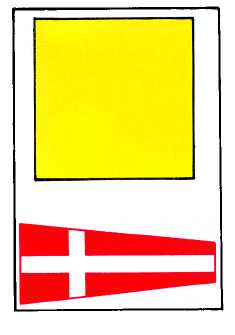| |
The calls for the various types of boats follow:
BOAT CALL
BOAT TYPE
Qp0
All boats
Qp1
Admiral's barge
Qp2
Chief of Staff barge or gig
Qp3
Staff gigs or motorboat
Q p 4
Captain's gig
Qp5
Boats under power
Qp6
Boats under sail
Q p 7
Boats under oar
Qp8 to Qp50
Reserved for local assignment
by commanding officer
Calls are usually assigned according to boat numbers.
An example of a call to own ship's boat is Qp52,
meaning own ship's powerboat number 2.
To call another ship's boat, the ship's call is placed
under the boat call. For example, Qp4Rp6p2 calls the
captain's gig of carrier 62.
The general recall for all boats to return to their ships
is QUEBEC hoisted singly.
Figure 5-12 illustrates the recall signal for the
captain's gig (QUEBEC over PENNANT FOUR).
STEERING A BOAT BY COMPASS
LEARNING OBJECTIVES: Describe how to
steer a boat by compass. Recognize compass
error and describe how to correct compass error.
Standard powerboats and landing boats are always
equipped with a compass. The coxswain uses this
instrument more than any other device in piloting the
craft to its destination.
Both the magnetic compass and the gyroscopic
compass were explained in Chapter 2 of this book;
hence, they are not discussed here. The rest of this
chapter does, however, explain many of the things you
must know about steering a boat by compass.
The coxswain must ensure that the compass light is
installed and operating for night runs. To follow a
compass course, the coxswain leaves the side of the ship,
swings around to the bow, and uses either the point
C118.49
Figure 5-12.–QUEBEC over Pennant Four.
where the anchor chain enters the water or, preferably,
the anchor buoy as point of departure. The coxswain
then steers the previously given compass course. By this
method the boat should arrive at its destination with little
difficulty if there is no wind or current, if the compass
is in good condition, and if no metal objects (such as
tools, or a large steel vessel passed en route) cause the
compass to deviate.
It is necessary for the coxswain to move approxi-
mately 100 yards away from the ship before taking the
compass reading. The reason is to prevent the magnetic
attraction of the ship's hull from influencing the
operation of the boat's compass.
Trust your compass. At times you may swear
something has gone wrong with it, but that is probably
your imagination, not a faulty compass. It is not a good
practice to try to make your way from ship to ship by
listening for the ship's bells.
Sound is deceptive in fog. Sound seem to come from
everywhere at once. If you should become lost, you may
have to listen for bells to try to find the nearest ship.
Never leave your ship without knowing which berth the
ship is in. Handle your compass with care so that you
can rely on it when you need it.
COMPASS ERROR
Two forces make up compass error. They are
variation and deviation. Earth is a huge magnet. The
north magnetic pole of Earth is over a thousand miles
5-15
|

